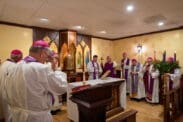Coat of Arms reflects archbishop’s Catholic heritage, Franciscan vocation
Published May 14, 2020
ATLANTA–For his motto, Archbishop Gregory Hartmayer, OFM Conv., uses the Latin phrase, “Pax et Bonum”–Peace and Good. They are the words used by St. Francis of Assisi in his greetings to others. The greeting embodied the simplicity and goodness he saw in all of God’s creation.
The episcopal heraldic achievement, or bishop’s coat of arms, is composed of a shield, with its charges, a motto scroll and the external ornaments indicating office. The shield is explained (in heraldic terms, blazoned) in twelfth century language and articulated as if it is being given to the bearer who will wear it on his arm. Thus, it must be remembered where the terms dexter (right) and sinister (left) are used, they are in fact, reversed as one views the shield from the front.
In church tradition, when a bishop becomes the ordinary of a diocese, the arms of his jurisdiction are joined (impaled) with his personal coat of arms. The coat of arms of the Archdiocese of Atlanta appears in the dexter impalement (left side for the viewer) while that of Archbishop Hartmayer appears in sinister (right side for the viewer). This custom of combining the two is meant to show the spiritual unity shared between the bishop as shepherd and the diocese as his flock–so core to the theology of being a bishop–that he also wears a ring on his right hand as a symbol of this union.
COAT OF ARMS OF THE ARCHDIOCESE
Its significance comes from symbols that uniquely represent the Archdiocese of Atlanta.
On the dexter for the archdiocese are three blue wavy bars that divide the shield into seven alternate wavy spaces of white and blue. In the center of the shield is an open gold crown and above on the upper bar is a Cherokee rose.
The seven white and blue bars are the heraldic equivalent of the sea and represent Atlanta, which is the See City and indirectly named after the Atlantic Ocean. The seven bars also recall the seven sacraments administered in the archdiocese. Blue and white are the colors of the Blessed Mother. The wavy aspects of the bars also symbolize the rolling foothills of the Blue Ridge country of north Georgia. The open gold crown represents the crown of Christ the King, the title of the Cathedral Church of the diocese. It may also have a secondary representation commemorating King George II of England after whom the state of Georgia was named. The Cherokee rose is the state flower.

COAT OF ARMS OF ARCHBISHOP HARTMAYER
The personal Coat of Arms of Archbishop Hartmayer is intended to symbolically represent the archbishop’s heritage and vocation as a Conventual Franciscan Friar. The background of wavy blue and white is a heraldic symbol for water. The archbishop is a native of Buffalo, New York–the Queen City of the Great Lakes. Water is also the key symbol of baptism. This helps recall the archbishop’s ministry as the primary sacramental minister of his diocese.
The eagle serves as a two-fold symbol of both the archbishop’s German heritage and of St. John the Evangelist. The archbishop’s father was named John and this is the archbishop’s middle name. The Celtic Knot, known as a Triquetra, represents the archbishop’s Irish heritage on his maternal side. And finally, the Tau is a reference to Archbishop Hartmayer’s vocation as a Conventual Franciscan Friar. St. Francis would sign his writing with a Tau, often painted it on the walls and doors of places where he stayed and would remind his friars that their habit was in the shape of a Tau cross illustrating that they must go into the world wearing this cross like an incarnation of Christ.
PROCESSIONAL CROSS
Behind the arms is placed a gold processional cross-the symbol of Episcopal office. For the processional cross, Archbishop Hartmayer has selected the Cross of San Damiano. The entire Franciscan movement began when St. Francis, while praying at the Chapel of San Damiano, heard the crucifix speak to him and say, “Francis, go rebuild my Church for it is falling to ruins.” St. Francis thought this was a literal command to rebuild the chapel that was in disrepair. Soon, however, he realized God was asking more of him.
PONTIFICAL HAT
Surrounding the shield and processional cross is the pontifical hat called the “galero,” with its ten tassels in four rows, on either side of the shield, all in green. These are the heraldic insignia of a prelate of the rank of archbishop by instruction of The Holy See of March 31, 1969. Before 1870, the pontifical hat was worn at solemn cavalcades held in conjunction with papal ceremonies.
Compiled by the Office of Communications of the Archdiocese of Atlanta.


